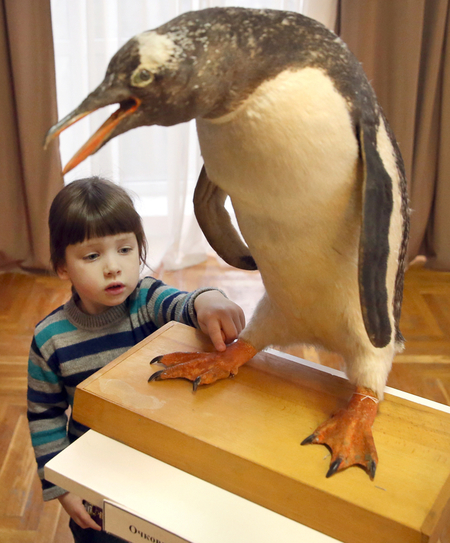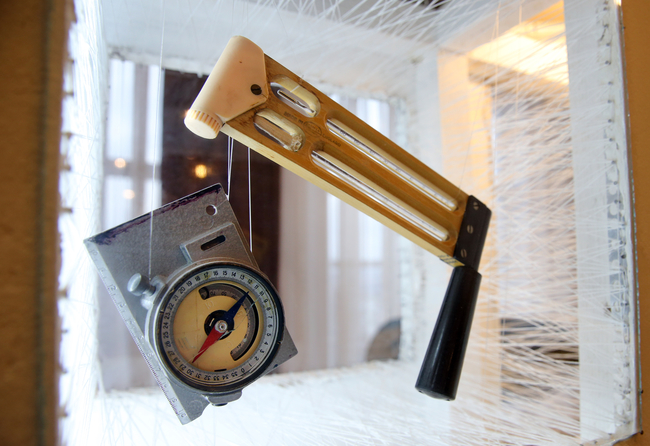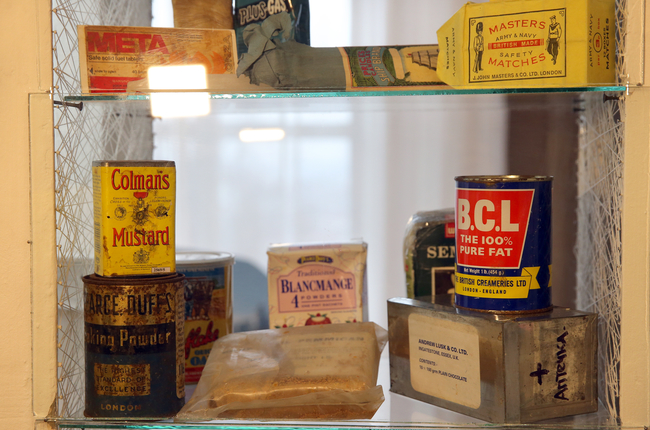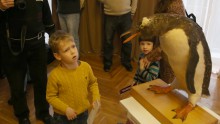“Ukrainian Antarctica” is the name of the exhibit, recently opened at the National Museum of the History of Ukraine in Kyiv. The project is dedicated to the 20th anniversary of the Antarctic research base Akademik Vernadsky. The exhibits include items from the base, brought by Ukrainian researchers, and a replica of the base. At the opening, the researchers presented the museum with a historic artifact: the flag, which was hoisted at the station on February 6, 1996. Now it is part of the museum’s collection. The Day was able to talk with the explorers about their everyday life, research, romance, and even penguins.
A STATION FOR A COIN
Among the exhibits is a one pound piece. This symbolic price was placed by the British, who agreed to hand the base over to Ukrainians. The problem was that after the collapse of the Soviet Union there loomed a risk for Ukraine to stop research in Antarctica.
“Ukraine still had specialists who could continue research in such conditions, but it did not have a station,” recollects Valerii Lytvynov, director of the National Antarctic Research Center. “We asked our Russian colleagues for one of the former Soviet stations, but we were refused. We were left effectively empty-handed. But then the British colleagues decided to close down their Faraday base after one of their scholars died there, and we started negotiations about a transfer.”

PENGUIN DO NOT SEEK THE COMPANY OF HUMANS, BUT ENJOY WATCHING US FROM A DISTANCE
The Brits gave the station away practically for nothing, but on condition that during the next decade our scholars would continue their research and would pass the results on. After the first decade was over, a new contract was made. Under it, the Ukrainians undertook to pass on information in exchange for technical maintenance and consulting.
Lytvynov says it was not so easy to collect exhibits for the exposition, because it is mostly the materials for research, not souvenirs, that are normally brought to Ukraine from the base: samples of microflora and microorganisms to be studied. “One thing is to collect samples on the site, but work continues also beyond the station. Our research is applied in pharmacology and cosmetology. It opens great opportunities since the microorganisms which we find live under extreme conditions, and their abilities are also extreme,” summarizes Lytvynov.
THE FIRST POLAR EXPLORER
Hennadii Milinevsky is the leader of the first Ukrainian Antarctic expedition. He had the honor of hoisting the Ukrainian flag above the station.

UKRAINE IS BUSY CONTINUING THE BRITS’ RESEARCH. MEANWHILE, THE UK, ACCORDING TO THE AGREEMENT, HELPS US TO IMPROVE THE EQUIPMENT. IN THE PHOTO: THE OBSOLETE METEOROLOGICAL INSTRUMENTS
“It was the outcome of hard work,” shares Milinevsky. “We had been negotiating for two years. The British colleagues wanted to test us and see if we would be able to work. We had to send our researches to the base at our own expense a year prior to the transfer, to get the British know-how. Two persons had to spend a winter there, which would cost 20,000 dollars. At that time my salary equaled to 10 dollars. Such expenditure was not foreseen in the budget, so we worked with donors (fortunately, we found them).”
“WOMEN WERE NOT REALLY WELCOME AT THE STATION”
Meteorologist Svitlana Krakivska took part in the second Ukrainian expedition to Antarctica. The group consisted of nine men and four women, but Krakivska recalls that access for women was much more complicated.
“Working at the station means a lot of physical labor: shoveling snow, carrying loads, etc. This argument is often used to explain why women are not really welcome at the station,” explains Krakivska. “So, I always say that, although I am weaker, I can do as much as the others. A man can lift 50 kilos at a time, I will do it in two goes. This is not a problem.”

IN THE WINTER THE STATION IS ISOLATED, SO THE SUPPLIES OF FOOD AND MEDICINES NEED TO BE DELIVERED BEFOREHAND
Krakivska’s stay at the base was shrouded in romance. This is where she met her husband-to-be, and before she left for home, she knew they would have a baby girl soon.
“We traveled a lot, me and my husband: by boat, by helicopter, and we hiked in the mountains,” recalls Krakivska. “As one of those tourists who travel to Antarctica every year said, you can find mountains in many parts of this world, or glaciers, for that matter. The most interesting here is the color scheme. You won’t find such shades of snow anywhere else outside Antarctica. And the underwater part of an iceberg is simply indescribable.”
There were no emergencies at the base, but the explorers were prepared to handle anything. “There is always someone who is awake. A fire would be the worst accident. We often had drills, so we could react in an emergency. A couple of times I even had to run outside when I was taking a shower. By the way, the alarm signal resembles a lot the tram bell. At first, when I came back to Kyiv, I would react to it, too.”
In Antarctica the rate of warming is considerably higher than the global average. When the global temperature rose less than by one degree, at the station it was three degrees. This affects the landscape considerably. “Now, when I look at our boys’ photos, I can’t recognize those places. We had drills there, climbed the glacier, but now it has collapsed. Where there used to be a cave, there is none now,” tells Krakivska.
THE NEW LIFE OF AKADEMIK VERNADSKY
The sixteenth Antarctic expedition worked at the base in 2011-12. Meteorologist Denys Pishniak is one of the members of that team. “Psychological problems were the worst,” tells Pishniak. “You are constantly isolated from your family and you keep worrying about them. The other problem is health. Health care at the station is limited. If anything serious should happen, it would hardly be possible to carry out timely evacuation. Natural conditions pose another danger. We have a smallish glacier, but it has cracks that reach dozens meters deep. From time to time they get covered with snow, and you can just sink and get lost. These cracks are impossible to spot, we just know where the dangerous zone is, and we try to keep out of it. I fell through a couple of times, but managed to hang on to my hands and climb out on time.”

THE REPLICA OF AKADEMIK VERNADSKY. UKRAINIAN EXPLORERS HEARD FROM THEIR BRITISH COLLEAGUES THAT ONLY 50 YEARS AGO ALL THOSE ROCK OUTCROPS WERE COVERED BY A GLACIER
Pishniak has been to Antarctica only once and cannot help admiring what he saw there. “Of course, the landscape is the first thing to astonish you. Then the fauna. All those penguins and seals are awfully slow. There are no predators on the mainland, so they are pretty much relaxed. Penguins are absolutely strange creatures, they will not let people closer by than a meter or so. But if you squat close by their group and wait a little, they will come on their own, circle you and watch. Moreover, they chat between themselves, probably trying to figure out what sort of weird penguin you are.”
Scholars emphasize Antarctica’s great importance. If the ice suddenly disappeared, the temperature on the planet would rise by five to seven degrees. Many countries would be no more fit for living. But the ozone hole above the glacier does not aggravate the situation, on the contrary, it helps. It causes a vortex around Antarctica, which slows down the melting.
The exhibit “Ukrainian Antarctica” will be open until May. The museum does not limit itself to exhibiting precious artifacts. Anton Bohdalov, director of the department of the history of independent Ukraine, promises to organize several public talks by the explorers.







